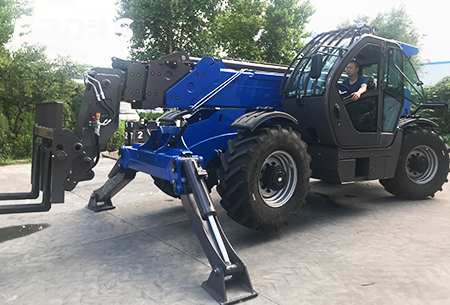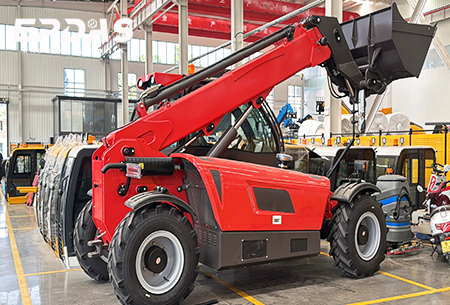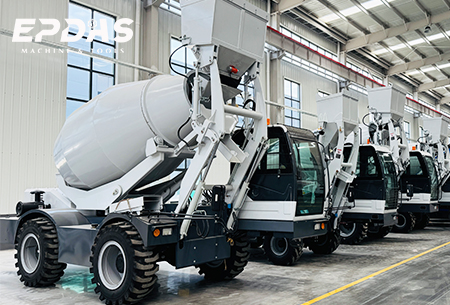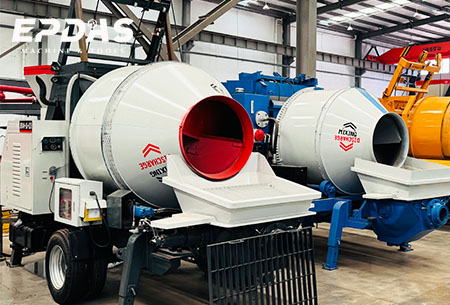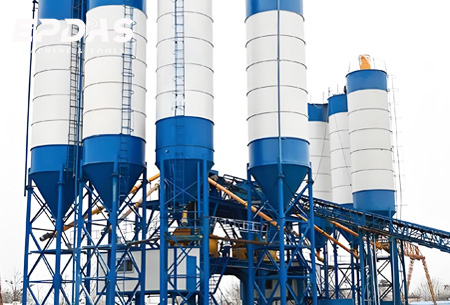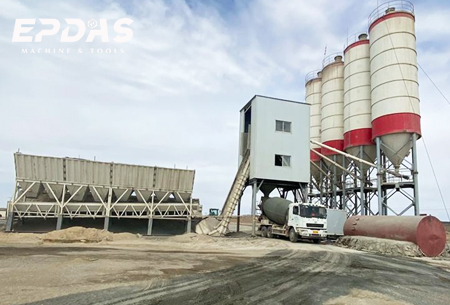Have you also encountered dust problems at construction sites? Studies have confirmed that exposure to concrete dust can lead to systemic health impairments such as lung function damage. Even with the adoption of comprehensive equipment protection measures, dust pollution is still difficult to be completely eliminated. Due to the diffusion characteristics of aerosols and the limitations of the working space, there is still a significant residual risk of dust pollution.Therefore, equipping concrete mixing plants with dust collection systems is of great significance.
Dust generation in dry-mixed concrete batching plants occurs throughout the entire production process. During raw material handling, the pressure impact from cement truck unloading causes dust to be released instantaneously; in aggregate storage areas, wind disturbance causes fine sand, stone powder, and other particles to continuously disperse.
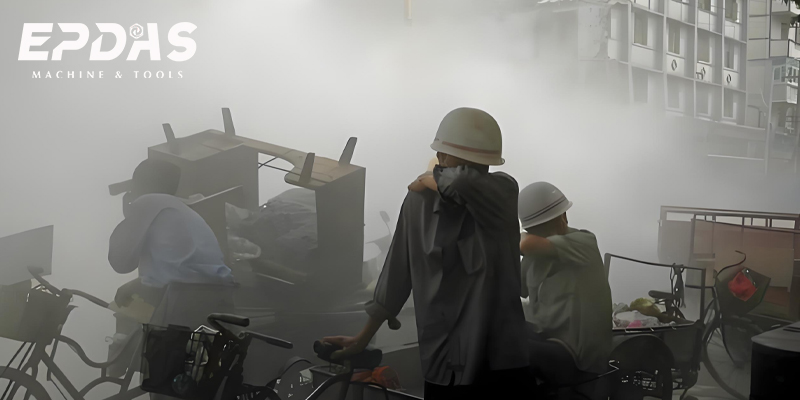
Once the material enters the mixing process, negative pressure caused by material flow at the mixer’s feed and discharge ports generates dust, and powdered materials form dust clouds as the mixing blades rotate at high speeds. During the storage phase, dust is continuously released from the breathing ports at the top of the silos and the interfaces of the screw conveyors due to changes in air pressure.
The EPDAS dry mix concrete batching plant dust control system, based on modular design and efficient filtration technology, can effectively address dust generated throughout the entire production process, including unloading, weighing, and mixing. The core components utilize nano-coated filter media combined with an intelligent pulse cleaning system to effectively reduce emissions of pollutants such as PM2.5 and PM10. This provides reliable environmental protection for construction projects, ensuring product quality stability from the source and achieving dual improvements in economic and environmental benefits.
Dry mix concrete batching plants(also known as dry mortar batching plants). It loads dry materials – aggregates, cement, and additives – into concrete mixer trucks where mixing occurs during transportation. This advanced system precisely measures and loads dry ingredients – including graded aggregates, Portland cement, and specialized chemical additives – into the drum of transit mixer trucks. The actual mixing process is then initiated during transportation by activating the truck’s rotating drum, allowing for controlled hydration timing.
This method is particularly valuable for:
It is a widely used type of concrete batching plant globally, the dry mix concrete batch plant comprises five core systems: automated aggregate batcher, sealed cement silo, high-precision weighing unit, intelligent central control system, and high-efficiency loading chute. These integrated subsystems, interconnected via industrial IoT technology, guarantee millimeter-level batching accuracy while achieving an average loading speed of 3m³ per minute.
The system’s distinctive feature lies in loading pre-proportioned dry materials into concrete mixer trucks without water addition. The innovative delayed mixing process, initiated during transit by water injection, effectively resolves the technical challenge of concrete slump loss over time. During raw material transportation, since no water is added, it avoids the initial setting of concrete due to time delays, significantly expanding the transportation radius.
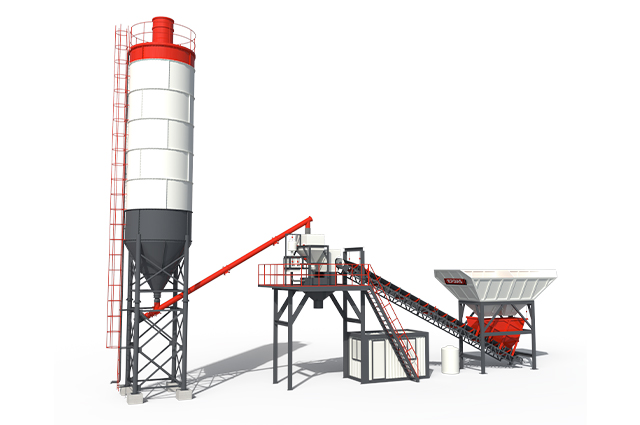
The structural design of the dry concrete batching plant is centered around “precise batching and efficient conveying,” and consists of five major systems:
♦ The Mixing Plant has a Simple Structure: As there is no need for a stirring host, the overall structure is simpler, the initial investment cost is lower, and maintenance is more convenient, making it suitable for projects with limited budgets.
♦ Wide Transportation and Feeding Range: Dry raw materials do not set during transportation and can be transported over long distances before being mixed with water, making it suitable for projects with a large feeding radius and dispersed construction sites.
♦ High Production Efficiency: The dry ready mix batching plant adopts a dry material transportation mode, effectively preventing premature concrete setting. This feature makes it particularly suitable for long-distance delivery and supplying dispersed construction sites,
♦ High Application Flexibility: It can provide raw materials for projects requiring on-site mixing, such as road maintenance, rural infrastructure, and small-scale construction projects, offering high flexibility and meeting the needs of different concrete mix designs.
♦ Environmental Control: Dust generation is concentrated during loading, conveying, and measurement. Targeted dust control equipment can effectively manage pollution, reducing the pressure on wastewater and slurry treatment compared to wet mixing plants.
♦ Formulation Adaptability: It can precisely blend various dry materials according to project requirements and is compatible with multiple additive combinations.
♦ Management Advantages: Mixing is completed on-site, reducing the pressure for centralized quality control at the plant and minimizing daily management and maintenance workloads.

Concrete, as an indispensable key material in modern construction engineering, has become the foundation choice for various construction projects due to its excellent durability and wide applicability. However, dust issues generated during concrete processing and use, particularly fine particles containing crystalline silica, pose a serious threat to the construction environment and human health.
These dust particles mainly come from the working processes such as concrete cutting, grinding, crushing and dry mixing. Without taking effective protective measures, the dust concentration at the construction site can increase the risk of illness for the workers. Therefore, the dust removal system is an important system for dust suppression in concrete mixing plants.
The dry concrete dust collection system is a specialized equipment system designed to control dust pollution during the production of dry ready mix concrete. Its core function is to capture and filter industrial dust generated during raw material processing, batching, and conveying.
This system operates on the principle of negative pressure dust collection. It sets up a closed dust collection hood at the dust generation point and uses the negative pressure airflow generated by the centrifugal fan to draw the dusty air into the treatment pipeline.
Cyclone separation: By using centrifugal force, large-sized aggregate debris and other dust are thrown towards the cylinder wall for sedimentation, reducing the load on subsequent filtration.
Bag filter: The dusty airflow passes through wear-resistant and high-temperature resistant filter bags to retain ultra-fine dust such as cement powder and fly ash. The clean air is discharged through the bags.
Activated carbon adsorption: Through the activated carbon adsorption layer, odors and trace harmful gases are removed to ensure that emissions meet standards.

Explosion-Proof Design: Utilizes anti-static filter materials and explosion relief devices for flammable dust such as cement.
Modular Structure: Enables flexible scalability of processing capacity based on production volume.
Anti-Condensation Technology: Heated insulation devices prevent moisture condensation and filter blockage during winter months.
Aggregates (sand and gravel) generate dust due to height differences and collisions during transfer via belt conveyors.
Powdered materials (cement, mineral powder) leak from pipe joints during pneumatic conveying.
Dust is generated by the impact of unloading powdered materials from silos.
Dust disperses due to rapid discharge from weighing hoppers.
Dust generated when dry materials enter the mixer.
Fine dust emitted during mixing due to mechanical force.
Dust generated at the discharge port after mixing is complete
Dust generated during loading of finished product silos
Concrete dust contains a large amount of crystalline silicon. If workers inhale it, it may cause lung diseases, lung cancer and chronic respiratory diseases, etc. What’s more serious is that dust can also irritate the skin and eyes, posing multiple threats to the health of workers.
Dust is actually the lost raw materials, especially high-value powders such as cement and fly ash. Collecting and recycling dust not only saves costs but also improves the utilization rate of raw materials.
Dust can reduce air quality. The PM2.5 it generates can cause foggy weather and reduce visibility. Dust sedimentation can change soil properties. Acidic and alkaline dust may cause eutrophication of water bodies. Heavy metal dust, when amplified through the food chain, poses a threat to ecological balance. Monitoring shows that industrial source dust is one of the main contributing factors to the excessive air quality in cities.
Dust accumulation in the mixing workshop can damage equipment and disrupt production. Advanced dust collectors and sealing systems reduce contamination by 60% and lower maintenance costs by more than half, ensuring reliable operation.
Dry mix concrete plants must meet the corresponding dust emission standards; otherwise, they will face fines and may even result in the project not being approved. Effective dust control is a necessary condition for meeting regulatory requirements.

Dust Collection Pipeline: The ductwork system transports dust-laden air from all emission points to the dust collection equipment. Pipeline design must account for multiple factors including equipment dimensions, duct length, number of dust sources, and dust properties. Proper pipe diameter and layout configuration prevent clogging, optimize dust capture efficiency, and minimize pressure loss (typically maintained below 15% of total system pressure).

Fan or Blower: It provides power for the dust removal system and drives the dusty airflow to flow in the pipeline. Its selection needs to take into account factors such as air volume and static pressure, and at the same time adapt to environmental temperature, dust wear resistance, humidity and other conditions. Centrifugal blowers are suitable for high static pressure scenarios, while axial flow fans are suitable for low pressure and high air flow situations.

Dust Filter: This is the core component of dust removal, responsible for separating dust particles in the airflow. The selection of filters should take into account the type of filter material, air flow resistance and the composition of contaminants. The ratio of air to filter cloth is a key performance indicator. The lower the ratio, the higher the filtration efficiency and the longer the service life of the filter material.

Filter Cleaning System: To prevent dust from accumulating on the surface of the filter material and affecting efficiency, the system is equipped with an automatic cleaning mechanism, such as reverse airflow cleaning, mechanical vibration or pulse jet cleaning. Among them, pulse jet cleaning is the most common. It removes dust from the filter material through a brief burst of compressed air to ensure the continuous operation of the system.
Dust Collection Container: It is used to store filtered dust for safe disposal or recycling. Container design is determined based on the characteristics of the dust, loading rate and operational requirements. Common types include sealed boxes, barrels or bags, rotary valves, screw conveyors, pneumatic conveying systems, etc.
This system uses filter bags to capture dust particles from dust-laden airflow, then removes the dust through pulsed reverse airflow using compressed air. It is applied to locations such as the tops of cement silos, powder weighing hoppers, and unloading points (loading ports), achieving dust removal efficiency of over 99%. It is particularly suitable for capturing fine dust particles such as cement powder and fly ash, with low maintenance costs and replaceable filter bags.
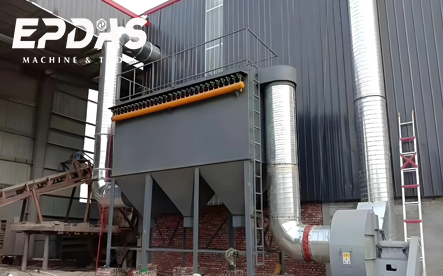
As dust-laden gas passes through pleated cartridges, dust particles are captured. The system periodically performs reverse air cleaning. It features a compact design with a large filtration area, flexible installation options, and is suitable for localized dust collection at feed openings, loading ports, or temporary work areas, offering high cleaning efficiency.
Utilizing the centrifugal force generated by rotating airflow, larger dust particles are flung toward the equipment walls and settle at the bottom. Typically used for primary dust collection after aggregate crushing or screening, as well as pre-treatment before baghouse filtration. It features a simple structure, durability, no need for filter media, and easy maintenance. However, it has a lower capture efficiency for fine dust and requires integration with other systems.
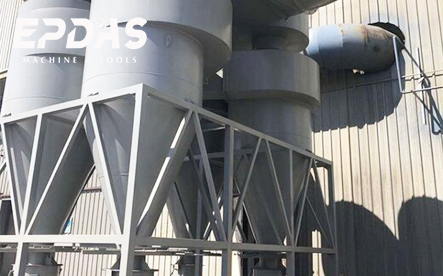
Dust collection hoods are installed at multiple dust-generating points, and dust-laden airflow is collected via pipelines and processed in a central dust collector. This system is suitable for centralized dust control across an entire facility, particularly large dry material mixing plants. It offers centralized management, high environmental compliance rates, and is suitable for projects with stringent environmental requirements. However, the system has relatively high investment costs.
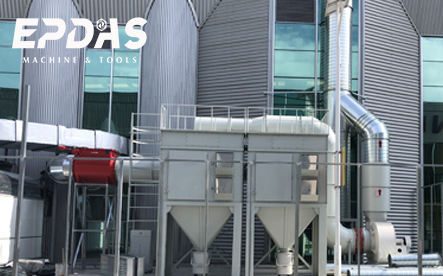
The dust collection system for dry concrete plants uses advanced German pulse bag technology, with a filtration precision of microns and a dust collection efficiency that exceeds conventional emission standards. The intelligent control system can automatically adjust operating parameters according to actual working conditions, ensuring dust collection effectiveness while achieving energy-efficient operation. The system is equipped with a variable frequency device that can significantly reduce energy consumption, and combined with an optimized flow channel design, further reduces power consumption.
The energy-saving variable frequency control system achieves a 30% reduction in energy consumption, significantly reducing energy use. The waste heat recovery device further improves energy utilization efficiency, ensuring more thorough use of energy; while the low-resistance design effectively reduces fan power consumption, achieving energy savings from multiple angles.
The remote monitoring platform of this system is equipped with real-time monitoring and intelligent diagnosis functions, effectively simplifying the equipment maintenance process. Special treated anti-static filter materials and corrosion-resistant stainless steel components are adopted to ensure the long-term stable operation of the equipment in complex environments. The modular design concept makes daily maintenance more convenient and efficient.
Principle: Water is atomized through nozzles and combines with dust in the air, causing the dust to settle.
Application locations: Aggregate storage yards, unloading platforms, factory area roads.
Advantages: Low cost, can reduce secondary dust, but it is necessary to avoid excessive wetting of materials or equipment.
Principle: It generates ultrafine droplets that combine with fine dust (PM10 or PM2.5) to cause it to settle.
Application locations: loading/unloading points, enclosed operation areas.
Advantages: It has a good control effect on fine dust and does not produce excessive moisture.
Enclosed Facilities
Application: Sealing conveyors, hoppers, and silos to restrict dust escape.
Advantages: Reduces dust in the air and improves indoor air quality.
Application: Install wind barriers in open-air stockpiles or areas prone to wind-driven dust to block wind-driven dust.
Advantages: Cost-effective, reduces dust dispersion outside the site.
Application: Install dust filters on truck loading ports.
Advantages: Reduces instantaneous dust release during loading.
Cement silo automatic dust removal device
Features: Pulse reverse blowing during loading and unloading to prevent blockages and reduce manual maintenance.
Features: Real-time tracking of dust concentration, automatic triggering of cleaning programs and issuance of fault alarms.
Advantages: Real-time monitoring and automatic cleaning are linked to maintain the optimal filtration efficiency of the dust removal system, avoiding a decline in suction to enhance the production efficiency of the mixing plant. Fault early warning shortens the time for troubleshooting and maintenance, and reduces unplanned downtime losses.
Features: The automatic batching system completes the material transfer through closed screw conveyors, belt conveyors and other equipment. The entire process has no exposed links, which can significantly reduce the dust leakage of materials during loading, unloading and transfer.
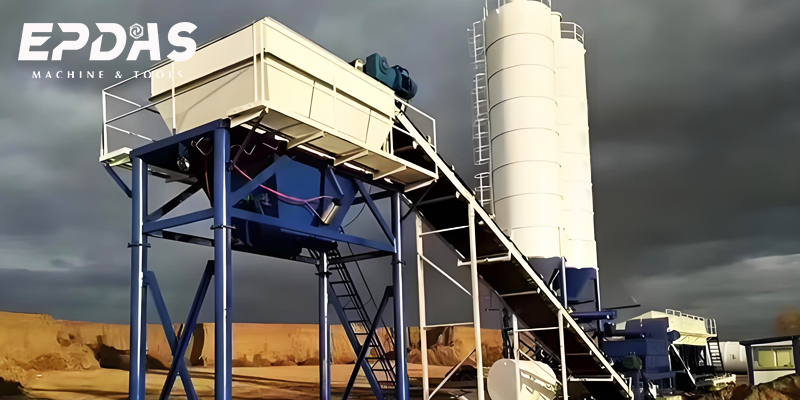
Scale and Layout of the Mixing Plant: Small-scale mixing plants typically have limited floor space, with compact equipment and constrained installation space for dust control facilities, often relying on decentralized single-unit dust collection systems for dust management. In contrast, large-scale mixing plants with high production capacity and dense equipment require systematic planning of dust control solutions, utilizing central dust collection systems to achieve coordinated dust suppression across multiple zones.
Major dust sources (material silos, conveyors, loading points, etc.): During material loading and unloading, the impact airflow generated by material drop height can carry dust outward. If the top breathing ports are not equipped with high-efficiency dust collection devices, a large amount of dust will escape. At transfer points and material discharge points of belt conveyors, material spillage and airflow disturbance can easily cause dust to become airborne. During concrete loading, the gap between the truck’s feed opening and the loading hopper, as well as the reverse airflow generated during unloading, are critical points for unorganized dust emissions.
Budget and long-term maintenance costs: The initial construction budget must cover the costs of purchasing, installing, and commissioning dust collection equipment, as well as pipeline installation. Although pulse jet baghouse dust collectors have high dust removal efficiency, their investment costs are more than three times that of cyclone dust collectors. In terms of long-term operation, costs such as filter bag replacement, fan energy consumption, and equipment maintenance need to be taken into account. Although high-efficiency equipment requires a large initial investment, it has good operational stability and low maintenance frequency.
EPDAS offers customized systems with exceptional flexibility and adaptability to suit the varying site sizes of different users, precisely meeting the specific requirements of diverse projects. In terms of regional differences, for rural sites characterized by vast areas with sparse populations and relatively underdeveloped infrastructure, the system can adopt decentralized dust control equipment and low-cost dust monitoring solutions to reduce initial investment and operational costs.
For urban areas with compact spaces and stringent environmental standards, the system is equipped with high-efficiency integrated dust control systems and connected to the urban environmental monitoring network to ensure real-time data compliance.
In terms of budget, for low-budget projects, the system prioritizes the deployment of core dust control equipment through modular configuration, with subsequent functional expansions; for projects with ample funding, it provides a full-process intelligent dust control solution covering high-precision monitoring, automated spraying dust suppression, and intelligent maintenance of dust removal equipment.
Optimize the layout of the mixing plant based on the characteristics of raw materials (such as aggregate particle size and powder fluidity)
Special protection systems are configured for extremely cold, hot or humid environments
Modular design supports flexible expansion of production capacity
Multi-stage dust removal solution (cyclone separation + pulse bag filter + activated carbon adsorption)
Dust emission concentration < 10 mg/m³, meeting EU CE international standards
Explosion-proof design suitable for flammable powder materials (e.g., aluminum powder)
Equipped with an IoT remote monitoring platform for real-time tracking of production data
Automatic diagnostic system alerts for equipment abnormalities, reducing downtime risks
Formula management system supports storage of multiple material ratios
Wear-resistant lining design (50% longer lifespan)
Freeze-resistant air supply system (operates normally at -30°C)
Corrosion-resistant coating treatment (suitable for coastal/chemical zones)
Concrete is a very useful material that can be manufactured in various ways and has a wide range of applications. However, how to manufacture concrete correctly and how to deal with the dust produced by concrete are of vital importance. Dust control in dry-mixed concrete mixing plants is a systematic project. It is not only a response to policies but also a long-term operational guarantee. Scientifically choosing a reasonable mixing plant can enhance equipment efficiency while controlling costs.
EPDAS, a professional manufacturer of machinery, can provide customers with customized environmental protection solutions for dry mixing plants, solving the dust treatment problems you are currently facing in construction projects. We will understand factors such as the scale of your project, equipment model, floor area, geographical location, and environmental conditions, and provide a suitable concrete dry material mixing plant. Contact us for more information!
